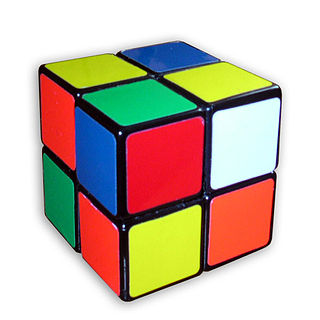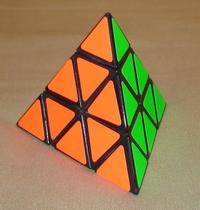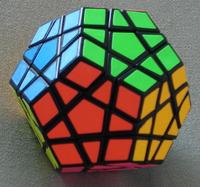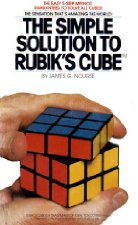Gilles Roux (born 20 January 1971) is a French speedcuber primarily known for inventing a 3x3x3 Rubik's Cube method, the Roux Method, and achieving fast times with it.
Gilles Roux (born 20 January 1971) is a French speedcuber primarily known for inventing a 3x3x3 Rubik's Cube method, the Roux Method, and achieving fast times with it.
Gilles Roux was a member of the World Cube Association Board from October 2004 until 1 November 2008. During his time as a board member, Gilles helped organize many competitions as a WCA delegate. He also contributed to WCA by creating much needed regulations which would in turn help out cubers all over the world. Presently, Gilles is a technical advisor for the WCA and assists when needed. [1]
Over a span of years, Gilles Roux developed his own method to solve the 3x3x3 cube. Using a smaller quantity of memorized algorithms than most methods of solving, Roux still found his method to be fast and efficient. The first step of the Roux method is to form a 3×2×1 block. The 3×2×1 block is usually placed in the lower portion of the left layer. The second step is to create another 3×2×1 on the opposite side. The remaining four corners are then solved using a set of algorithms known as CMLL (Corners of the Last Layer, without regards to the M-slice), which leaves six edges and four centers that are solved in the last step.

For official results, solves must be completed in a competition held by the WCA. In competition, Gilles has recorded a single solve of 10.06 seconds, ranking him in the top twenty thousand solvers in the world (as of 1 January 2025). [2] His best average of 5 was set on 16 September 2011 at 13.03. [3] Also his greatest achieved fewest moves competition for the standard 3x3x3 is 31, being part of the "31 club", coming to a draw with another known cuber and creator of popular method of solving, Lars Petrus.

The Rubik's Cube is a 3D combination puzzle invented in 1974 by Hungarian sculptor and professor of architecture Ernő Rubik. Originally called the Magic Cube, the puzzle was licensed by Rubik to be sold by Pentangle Puzzles in the UK in 1978, and then by Ideal Toy Corp in 1980 via businessman Tibor Laczi and Seven Towns founder Tom Kremer. The cube was released internationally in 1980 and became one of the most recognized icons in popular culture. It won the 1980 German Game of the Year special award for Best Puzzle. As of January 2024, around 500 million cubes had been sold worldwide, making it the world's bestselling puzzle game and bestselling toy. The Rubik's Cube was inducted into the US National Toy Hall of Fame in 2014.

The Pocket Cube is a 2×2×2 combination puzzle invented in 1970 by American puzzle designer Larry D. Nichols. The cube consists of 8 pieces, which are all corners.

Minh Thai is a Vietnamese-American speedcuber. As a sixteen-year-old Eagles Rock High School student from Los Angeles, he won the first world championship on June 5, 1982 in Budapest by solving a Rubik's Cube in 22.95 seconds. He is also the author of the book The Winning Solution (1982), a guide to solving the cube. Later, Ortega Corners-First Solution Method for Rubik's Cube was based on Minh Thai's Winning Solution.

Speedcubing, also referred to as speedsolving, is a competitive mind sport centered around the rapid solving of various combination puzzles. The most prominent puzzle in this category is the 3×3×3 puzzle, commonly known as the Rubik's Cube. Participants in this sport are called "speedcubers", who focus specifically on solving these puzzles at high speeds to get low clock times. The essential aspect of solving these puzzles typically involves executing a series of predefined algorithms in a particular sequence with eidetic prediction and finger tricks.

The Professor's Cube is a 5×5×5 version of the original Rubik's Cube. It has qualities in common with both the 3×3×3 Rubik's Cube and the 4×4×4 Rubik's Revenge, and solution strategies for both can be applied.

The Pyraminx is a regular tetrahedron puzzle in the style of Rubik's Cube. It was made and patented by Uwe Mèffert after the original 3 layered Rubik's Cube by Ernő Rubik, and introduced by Tomy Toys of Japan in 1981.

The Megaminx or Mégaminx is a dodecahedron-shaped puzzle similar to the Rubik's Cube. It has a total of 50 movable pieces to rearrange, compared to the 20 movable pieces of the Rubik's Cube.
Jessica Fridrich is a professor at Binghamton University, who specializes in data hiding applications in digital imagery. She is also known for documenting and popularizing the CFOP method, one of the most commonly used methods for speedsolving the Rubik's Cube, also known as speedcubing. She is considered one of the pioneers of speedcubing, along with Lars Petrus. Nearly all of the fastest speedcubers have based their methods on Fridrich's, usually referred to as CFOP, that is,.

The World Cube Association (WCA) is the worldwide non-profit organization that regulates and holds competitions for mechanical puzzles that are operated by twisting groups of pieces, commonly known as twisty puzzles. The most famous of those puzzles is the Rubik's Cube. Since the start of the WCA there have been over 11,700 competitions. The WCA was founded by Ron van Bruchem of the Netherlands and Tyson Mao of the United States in 2004. The goal of the World Cube Association is to have "more competitions in more countries with more people and more fun, under fair and equal conditions." In 2017, they started work to become a non-profit organization and on November 20, 2017, the state of California accepted the initial registration of the World Cube Association.
Lars Erik Petrus is a Swedish accomplished speedcuber. He has been described as a Rubik's Cube icon and master.

The CFOP method, also known as the Fridrich method, is one of the most commonly used methods in speedsolving a 3×3×3 Rubik's Cube. It is one of the fastest methods with the other most notable ones being Roux and ZZ. This method was first developed in the early 1980s, combining innovations by a number of speedcubers. Jessica Fridrich, a Czech speedcuber and the namesake of the method, is generally credited for popularizing it by publishing it online in 1997.

Tyson Mao is an American Rubik's Cube speedsolver. He is a co-founder and a former board member of the World Cube Association, an organization that holds competitive events for the Rubik's Cube. In 2005, he set the world record for 3x3x3 blindfolded. In 2006, he appeared on the CW Television Network's Beauty and the Geek as one of the participants of the second incarnation of the reality television show.
Eric Limeback is a Canadian speedcuber. He is known for his 11/11 3x3x3 multiblindfold Canadian record solve, as well as his standard 3x3x3 blindfolded solving. Limeback was the first Canadian to record a sub-30 second official 3x3x3 blindfolded solve. Limeback began solving the Rubik's Cube in 9th grade. He graduated from Marc Garneau Collegiate Institute in 2010. He formerly held the Guinness World Record for the most 3x3x3 cubes solved in 24 hours, 5800, set from 3–4 October 2013 at Wilfrid Laurier University, Canada.

The Simple Solution to Rubik's Cube by James G. Nourse is a book that was published in 1981. The book explains how to solve the Rubik's Cube. The book became the best-selling book of 1981, selling 6,680,000 copies that year. It was the fastest-selling title in the 36-year history of Bantam Books.

Feliks Aleksanders Zemdegs is an Australian Rubik's Cube speedsolver. He is one of only two speedcubers ever to win the World Cube Association World Championship twice, winning in 2013 and 2015, and is widely considered the most successful and greatest speedcuber of all time. He has set more than 350 records across various speedcubing events: 121 world records, 216 continental records, and 7 national records.

René Schoof is a mathematician from the Netherlands who works in number theory, arithmetic geometry, and coding theory.

Mats Valk is a Dutch Rubik's Cube speedsolver. He broke the Rubik's cube single solve world record twice with times of 5.55 seconds in 2013 and 4.74 seconds in 2016. He won the Rubik's Cube European Championship in 2018 and was runner-up for 3x3x3 at the Rubik's Cube World Championships in 2013 and 2015.
The Layer by Layer method, also known as the beginners' method, is a method of solving the 3x3x3 Rubik's Cube. Many beginners' methods use this approach, and it also forms the basis of the CFOP speedcubing technique.
Vincent Sheu is an American speedcuber or Rubik's Cube solver from Saratoga, California known for organizing World Cube Association competitions and setting world records in both the Fewest Moves event and the 2x2x2 single solve. He currently serves as a Director and Delegate for the World Cube Association (WCA) and has been an organizer of every annual US Nationals Cubing Competition since 2010. Sheu previously served as the first Chair of the WCA's Regulations Committee with Lucas Garron from 2012 to 2015, directing a complete redrafting of the official competition regulations and guidelines during his tenure. He has received media attention as the subject of several viral images and video clips at various college sporting events.
Yiheng Wang is a Chinese competitive speedcuber. He currently holds the Rubik's Cube world record average of 4.05 seconds and third fastest 3×3×3 single of 3.27 seconds.